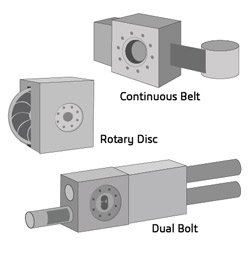

June 16 2015

Are you familiar with the term “continuous screen changer,” but not exactly sure what it is? A continuous screen changer is a machine that filters out impurities in the polymer extrusion process—without interrupting the process when a dirty screen needs to be changed. It’s used in melt filtration processes where debris can clog up screens in a very short time and process disruptions are costly. Markets and extrusion processes that employ continuous screen changers include pipe and profile, film and sheet, compounding, resin production, blow molding, nonwovens, and specialty material.
Types of Continuous Screen Changers
There are three primary types of continuous screen changer, each with its own characteristics:
Which Type is Best?
All continuous screen changers offer an uninterrupted melt flow—but not all are created equal. For example, although their relatively constant pressure can be a plus, rotary disc screen changers are prone to leakage due to seal wear. Rotary discs are harder to maintain and can be difficult to assemble after cleaning. Due to their design, there’s a significant degree of metal-to-metal contact, which results in wear over time.
There are downsides to a dual-bolt machine as well. Pressure drops significantly during a screen change, and this machine is prone to leaks or jamming under high pressure. Also, due to the overall size and construction of a dual bolt machine, its cost is fairly high.
Continuous belt screen changers offer numerous advantages over both rotary disc and dual bolt machines. They are smartly constructed for easier assembly—a plus for maintenance and cleaning. There’s minimal metal-to-metal contact, meaning less wear. Continuous belt screen changers experience no pressure drop during a screen change, and tend not to leak or jam. And lastly, they offer the lowest machine cost and frequently the lowest consumable screen cost.